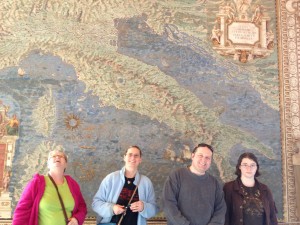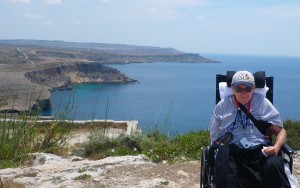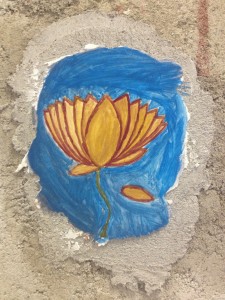We started at the Visitor Center for the Hagar Qim temple complex. It was another informative exhibit with models that showed where the light shines in the lower temple, Mnajdra at both equinoxes and solstices.

Then we headed outside to the temples themselves. They have been covered by large plastic tents to help preserve the site, but which lose the context of the temples’ true surroundings, which in this location is a huge hill overlooking the sea and a small rock island just offshore.

The diffuse light in the tents is lovely on the warm colored stone. I took a couple of portraits of both Pat and Gwen in Mnajdra. When else do you get a chance to take a portrait of someone in a 5000 year old temple?

We were again extremely fortunate. Most of the time we had both temples to ourselves.
Mnajdra is about a 10 minute walk down a paved path from Hagar Qim and only 3 other people were there the entire time we spent there. Most visitors don’t want to brave the long walk in the sun.

Rose, our guide, told us of being in Mnajdra temple with other guides and archeologists as solstice dawned she placed her hands on the rocks where the sunbeam touches as it moves into the space. It was enough to give goosebumps. Even after almost 30 minutes, it was hard to leave such a wondrous place, built so long ago by people we know almost nothing about. We trudged back up the hill, spent a few more minutes at Hagar Qim and then we were in the car for lunch at Marsaxlokk, a bustling fishing village that we had visited with Jack two years ago. I did a few minutes quick shopping, snapped a few photos and then we were whisked off to our appointment at the Hypogeum.
The Hypogeum of Hal Saflieni is an underground temple of about the same era as the other temples and made in several stages. Like the other temples, it is designated a World Heritage site by Unesco. The Hypogeum was carved out of the rock, but in such a way to look like it was assembled. It’s quite complex and winding. Only 80 people per day are permitted to see it, at a rate of 10 per hour. To help with preservation, the lights are calibrated so that only the area where the tour is standing is lit. The environment is very closely controlled. Tickets are rarely available on the day of the tour and we reserved ours back in November. Rose was glad that we had because the Hypogeum is the most amazing of the sites on Malta and the most difficult to see without planning ahead.
And of course, no pictures were permitted, in fact no bags at all were allowed. There was an audio guide and we were accompanied by a guard who directed us where to go along with the audio tour. It was truly an experience to stand in these rooms that had been carved from solid rock with only antlers and rocks. Gently curved walls and faux beams exuded an elegance that surprised me with its sophistication. Several theories were presented as who these people were and why they built this amazing structure, but the facts were few. The bones of about 7,000 people were found there. Several beautiful sculptural pieces including The Sleeping Lady were found there as well. The accoustic properties of one chamber create a resonance frequency for the room when spoken or sung into at certain frequencies. All of these mysteries may never be solved. I came away from our time underground with a deep sense of wonder at these ancient ancestors.
Still reeling from the Hypogeum, Rose suggested we take in the nearby Tarxien Temple complex instead of waiting until tomorrow as scheduled. It closed at 4pm and it was only a little after 2 and it would be one less thing on Monday when we had to be at the airport about noon. We agreed and were not disappointed.

Tarxien Temples are not far from the Hypogeum and there are theories that they are linked since the temples in Malta seem to be located in pairs. This was also a large complex, but the local area encroaches right up to it. In fact, there is a cemetery you can see right over the boundary wall from one of the walkways. It was discovered while the Hypogeum was still under excavation. On this site were found many pieces of the temple with carved patterns and animals. Many of the original pieces of work had been replaced with duplicates. The originals are on view at the Archeology museum in Valletta.
After Tarxien closed and we had to leave, Rose took us to the Dingli Cart Ruts next. Here the stone hillside is criss-crossed with mysterious ruts that look like wheel ruts, but Malta hadn’t developed the wheel when these were made. A Roman Quarry on the hillside gives clues that rocks may have been cut there and transported, but how? A theory about using roller stones in tracks has been presented. Another mystery. There was also a cave on the hillside that served as shelter for humans even into the recent past. This is one of the highest spots on the island and commands another impressive view in all directions.

From the cart ruts it was only a few minutes to the Dingli cliffs. Here the high point of Malta overlooks the sea. A tiny church there, St Mary Magdalene, is only open once a month. It’s doors were open when we arrived and after snapping a few photos of the amazing ocean view we went inside. (These views just don’t get old.) It was a small, peaceful place with seats only for 18 on folding chairs, but featured a lovely altar.

We purchased some local goods, prickly pear liquor made from the prickly pear cactus, honey and fresh tangerines.
We had some crepes for dinner by the hotel and packed to leave after the next morning’s tour. Pat and I spent a bit of time in the Bugibba temple at the hotel, puzzling out the placement of the stones that we didn’t understand when we first arrived. I also took a few nighttime portraits. We stood in the temple and watched the moon, thinking about the people who once stood in the same place thousands of years before.

This three day adventure was too much to squeeze into one post, so this is the third of four. Here are links to the others.
Part I
Part II
Part IV









































